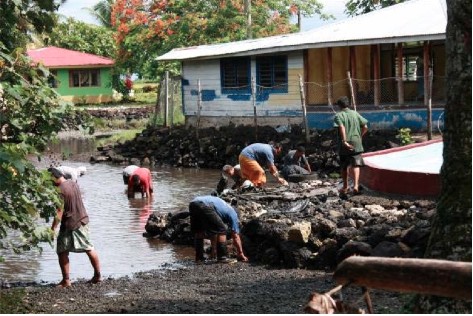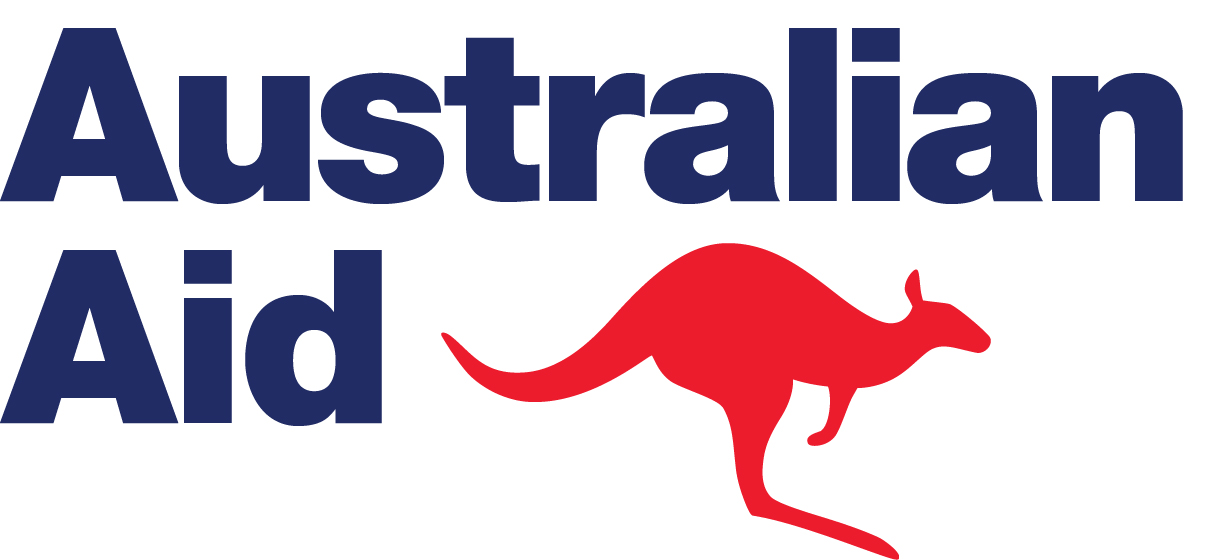CBA Samoa: Protection and Conservation of Mangroves, Eco-Systems, and Coral Reefs - Fasitootai
Project Overview
The tropical climate of Fasitootai, Samoa is marked by a distinct wet and warm (November - April) and dry and cool (May - October) seasons. The tropical cyclone season occurs in the months of December thru February, bringing with it approximately 66% of the total annual precipitation. Thus, vulnerability to coastal erosion and flooding is significant during the wet and warm season. Damaging winds result from higher frequency of storms, sea level-rise and high frequency of heavy rains. These factors alter the fragile terrestrial and marine biodiversity upon which the village relies on for basic necessities (food, income) and protection from storm surges.
This Community-Based Adaptation project increases the resilience of local mangroves and coral reefs to climate change-driven erosion and flooding, supporting healthy ecosystems and the sustainable well-being of Fasitootai and Vailuutai community members. Coastline infrastructure will reduce erosion and land degradation while helping to protect the mangroves, which in turn provide breeding habitat for fish and other marine life. Community Awareness Programs (CAP) will inform the community and raise their awareness on the connection between ecosystems, their livelihoods, and climate change. These training sessions will make them receptive and supportive of policies that dictate the development, sustainability, and replicability of the project.
* This project is part of UNDP's "Community-Based Adaptation" portfolio. *
Project Details
Samoa is an archipelago situated in the South Pacific, consisting of two large mountainous islands, Upolu and Savai’i, and seven other small ones. The economy is dependent on remittances, tourism, development aid and agricultural exports.
This project focuses on Fasitootai village, which is situated on the leeward north coast of Upolu. The climate is typical of Samoa, marked by a distinct wet and warm season from November to April, and a less wet and cooler season from May to October.
The project area encompasses two threatened ecosystems of global significance. The mangrove ecosystem is estimated to cover 2 hectares and houses numerous fauna and flora. It also includes freshwater pools used for drinking, bathing and recreation. The coral reef ecosystem includes a lagoon and coral, fish and marine life habitats.
A large percentage of the community depends on subsistence or semi-subsistence farming and fishing. Accordingly, residents rely heavily on these ecosystems for food, medicine and to generate income. The ecosystems also serve as natural barrier to storm surges during cyclones. Notwithstanding, they are subject to numerous climate change-induced threats. The village has reported that that mangroves are dying, coral bleaching events are becoming more common, and land is receding approximately 4 meters per year as a result of both climate hazards and baseline human development issues.
This Community-Based Adaptation project seeks to improve the adaptive capacity and reduce the vulnerability of Fasitootai’s mangrove and coral reef ecosystems to climate change risks associated with storm surges, sea level rise, tropical cyclones and flooding. It was formulated the community recognized the severe impacts of climate change on local livelihoods and welfare.
Accordingly, the project will design and construct shoreline protection structures to stabilize the coastline. 5,000 square meters that have been eroded away by the ocean will be reclaimed through the planting of mangroves. The three freshwater pools used for drinking, bathing and recreation will be renovated, and a Special Management Area will be established to protect mangroves and coral reefs.
The project also includes an education component that helps raise residents’ awareness and build their capacities on climate change adaptation. The knowledge acquired empowers the community with the skills needed to better understand and anticipate climate change impacts and how to protect their valuable and irreplaceable ecosystems. Altogether, these activities improve the resilience of Fasitootai’s ecosystems to climate change and reduce the community’s vulnerability to climate variability.
Key Results and Outputs
Outcome 1: Climate change considerations integrated into local policy and planning processes.
Develop a climate change resilient Coastal Natural Resource Management Plan (Output 1.1) and integrate climate change into village plans, such as Coastal Infrastructure Management Plans (Output 1.2). Obtain stakeholders’ agreement to declare the mangroves, ecosystems and coral reef as a Special Protected Management Area (Output 1.3).
Outcome 2: Increased awareness and understanding of climate change impacts
Facilitate Training, Education and Awareness Program (TEAP) on climate change (Output 2.1). Implement Anti-Litter & Disposal Campaign, organize village-wide clean-up, and improve Waste Management in adjacent areas to mangroves and lagoon and coral reefs to minimize discharge to mangroves and lagoon (Output 2.2). Facilitate program on Awareness, Protection and Mitigation against Human Driven Actions that have long-term impacts on the mangroves, eco-systems, and coral reef increasing their vulnerability to climatic driven changes (Output 2.3).
Outcome 3: Coral and mangrove eco-systems are better able to maintain eco-systems services in the face of climate change pressures.
Reinforce stream-lagoon mouth against storm-driven erosion and widening (Output 3.1). Deepen stream mouth and lagoon areas that have filled with sand deposited during storms surges to allow spawning area for fish, mud crabs, and other marine life (Output 3.2). Reinforce natural coastal buffers (mangroves) through nursery and replanting programs (Output 3.3). Review existing signed agreement that established Marine Protected Area or Faasao (Output 3.4). Raise and repair the concrete walls of spring water pools to protect against seawater and mud intrusion, improving and increasing spring water flow (Output 3.5).
Outcome 4: Economic activities that protect eco-systems that buffer the community from climate change risks developed
Develop an Eco-Tourism Plan (Output 4.1) and seawater fish farm with awareness and education components (Output 4.2). Identify, record, protect and restore historical sites such as first LMS Missionary John Williams first home in Samoa and his old vessel that sunk in the lagoon (not climate change related, but included for completeness of vision) (Output 4.3). Clean up Swamp and Wetland for future development of a freshwater fish farm (tilapia) (Output 4.4).
Reports and Publications
Brochures, Posters, Communications Products
News article
CBA Samoa - Fasitootai - 100 Volunteers mangrove planting news article (Dec. 2010)
PIFs
Project Brief / Fact Sheet
Multimedia
TOFIGA O PILI AAU - Samoa CBA Project (Pt. 2)
This is a shortened version of an original 25-minute video created through a participatory process at the sites of UNDP's Community-Based Adaptation projects in Samoa. It features the initiatives of vulnerable communities as they act to mitigate the impacts of climate chaneg on their environment, livelihoods and infrastructure.
TOFIGA O PILI AAU - Samoa CBA Project (Pt. 1)
This is a shortened version of an original 25-minute video created through a participatory process at the sites of UNDP's Community-Based Adaptation projects in Samoa. It features the initiatives of vulnerable communities as they act to mitigate the impacts of climate chaneg on their environment, livelihoods and infrastructure.
Monitoring and Evaluation
Monitoring will help determine progress of improvements on ecosystem protection and resilience. This will allow any fine adjustments to the plan if results as expected are not realized. And because continue external funding of the project is contingent on the reporting of successful improvements, it is very important that these indicators are accurately measured and quantified.
The indicators which will be used to monitor progress of adaptation resilient of mitigations undertaken are identified in the project document. These indicators are easily measured and quantified. The indicators are divided between:
• The VRA (adaptive capacity),
• The IAS (global environmental benefits)
Reporting period is every 6 months. At reporting period, measurements of the identified indicators are taken and reported. Report includes:
• Measured level of adaptation
• Reasons for any or lack of changes, and
• Corrective actions.
Taking Measurements and Reporting of VRA and IAS are taken every six (6) at the months stated as follows. Continued funding under the CBA program is contingent on the achievements as reported in the M&E report.







